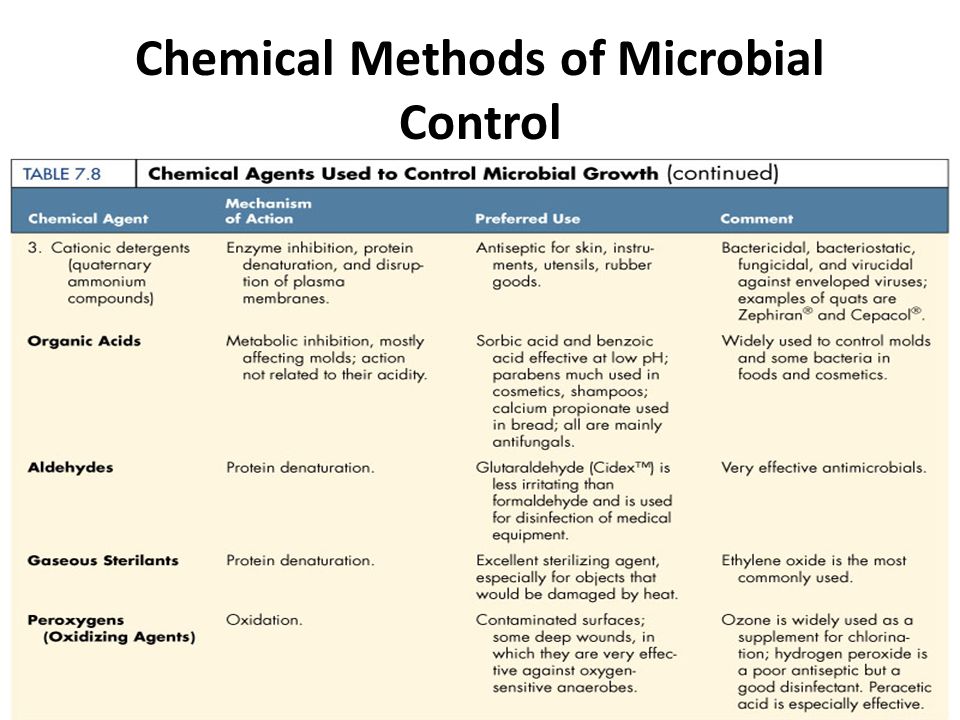The higher temperatures kill most contaminating microbes and endospores and therefore effectively sterilize the food. Phenol and phenolic compounds.

Controlling The Growth Of Microorganisms Ppt Video Online Download
Use of moist heat can control microbial growth in many circumstances but heat-sensitive items and those susceptible to moisture cannot be sterilized in.

. The use of a chemical sterilant to kill all microbial life. Although highly effective incineration isnt a method you can use with just. It can be used on living tissue or nonliving.
Virucide is a chemical known to inactivate viruses. Effective alone or in compounds. U Sodium hypochlorite NaOCl.
5 Chemical Methods of Microbial Control Types of Disinfectants 2. Recently silver has been considered in new applications for microbial control such as impregnating surgical dressings and infusing food containers with silver. Question 10 Which of the following is a chemical means of controlling microbial growth.
The straining of a fluid or air through a membrane to trap microorganisms. Heavy metals and their compounds. Incineration or burning materials to ashes is one of the most effective measures to control microbial growth.
Gas which sterilizes without heat but has to be used. U When mixed in water forms hypochlorous acid. Check all that apply disinfectant antibiotics 3.
Surface-active agents or surfactants decrease surface tension among molecules of a liquid. Commonly used chemical preservatives include sorbic acid benzoic acid and propionic acid and their more soluble salts potassium sorbate sodium benzoate and calcium propionate all of which are used to control the growth of molds in acidic foods. Effective safe and nonirritating for skin degerming B.
The purpose of controlling microbial growth To stop spreading the diseases or food spoilage. QUESTION 6 Match each of the following Chemical Means of Microbial Control with its BEST description. Chemical agents are generally not intended to achieve sterilization.
Fungicide is a chemical that can kill fungal spores hyphae and yeasts. Bactericide s kill bacteria viricide s kill or inactivate viruses and fungicide s kill fungi. These additives help to prevent the growth of Clostridium botulinum by inhibiting certain iron-containing enzymes of the organism.
The use of intermittent heat. Physical and chemical methods of microbial control that kill the targeted microorganism are identified by the suffix -cide or -cidal. Microorganisms are controlled by means of physical agents and chemical agents.
Control by chemical agents refers to the use of disinfectants antiseptics antibiotics and chemotherapeutic antimicrobial chemicals. Biocide is a substance that kills all living things but especially microorganisms. A bacteriostatic agent or bacteriostat abbreviated Bstatic is a biological or chemical agent that stops bacteria from reproducing while not necessarily harming them.
Which of the following correctly describes a method of chemical control used to control microbial growth. Is active ingredient of. The use of radiation to eliminate most microbial life.
Disruption of plasma membranes. Phenolics exert antimicrobial activity by injuring lipid-containing plasma membranes which causes the cellular components to leak out of the cell. This is an example of chemical food preservation.
Which of the following is used to prepare the skin prior to drain a blood specimen. Which of the following correctly describes a method of chemical control used to control microbial growth. Cl 2 H 2 O ----- H Cl- HOCl Hypochlorousacid u Used to disinfect drinking water pools and sewage.
The prefix indicates the type of microbe or infectious agent killed by the treatment method. Chemical agents to control microorganisms. In which of the following are examples of physical methods of microbial control.
Disinfectant High temperature Scrubbing action Ultraviolet radiation Disinfectant. Describe the patterns of microbial death caused by treatments with microbial control agents. Depending on their application bacteriostatic antibiotics disinfectants antiseptics and.
In which of the following are chemical means of microbial control. Chemical Methods of Control. Sporicide is a chemical agent capable of killing bacterial spores.
- Phenolics r lodophor Chlorine -v Alcoho A. U Chlorine is easily inactivated by organic materials. Sterilization disinfection antisepsis degerming sanitization biocide germicide bacteriostasis and asepsis.
Match the microbial control term with its description antiseptic a chemical used to remove or destroy vegetative pathogens on skin tissue disinfectant a chemical used to remove or destroy vegetative pathogens on inanimate objects sterilization a process that destroys or removes all forms of microbial life including. Chemical preservatives are used to inhibit microbial growth and minimize spoilage in some foods. An ideal disinfectant or antiseptic chemical agent kills microorganisms in the shortest possible time without damaging the material treated.
Surface-active agents for removal of microbes. Define the following key terms related to microbial control. Physical agents include such methods of control as high or low temperature desiccation osmotic pressure radiation and filtration.
Select all that apply. Most reduce the microbial populations to safe levels or remove pathogens from objects. Germicide or microbicide kills pathogenic microorganisms.
Used for disenfection of medical equipment it can be considered a liquid sterilizing agent C. Sterilization - Destruction of all forms of microbes including endospores by steam under pressure or ethylene oxide Disinfection -Destruction of vegetative cells of pathogenic microorganisms by chemicals or physical methods Pasteurization - Application of high temperature 72 0 C.

Chemical Methods Of Microbial Control Chemical Bond Chemical Method


0 Comments